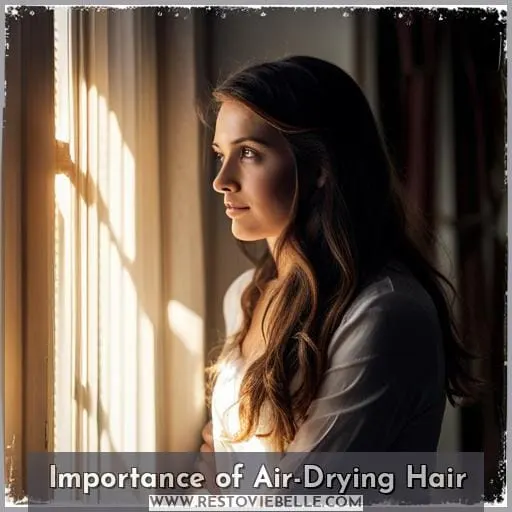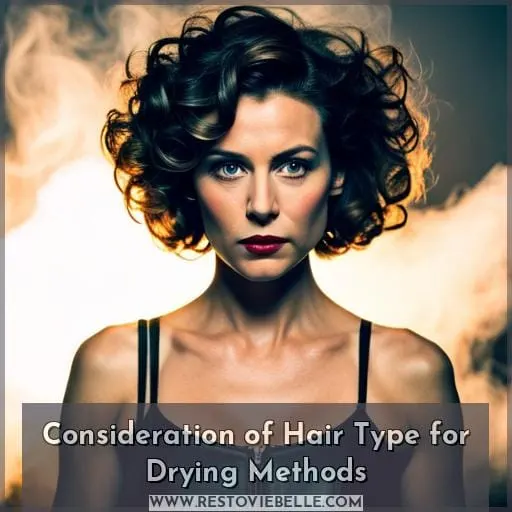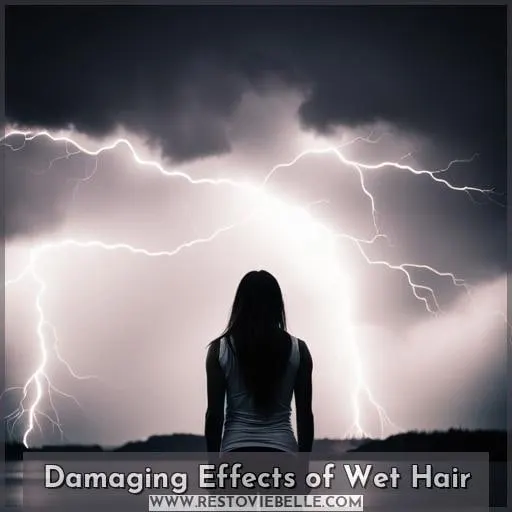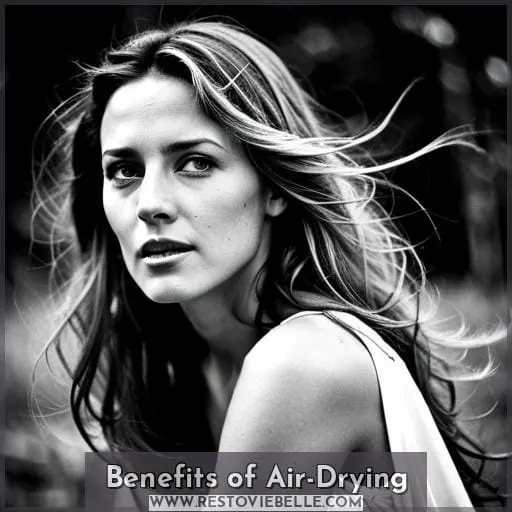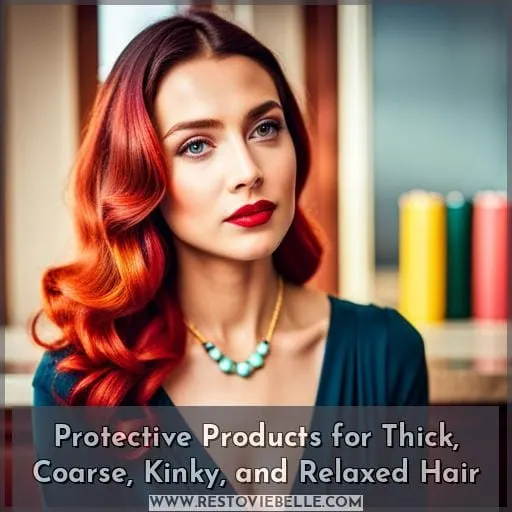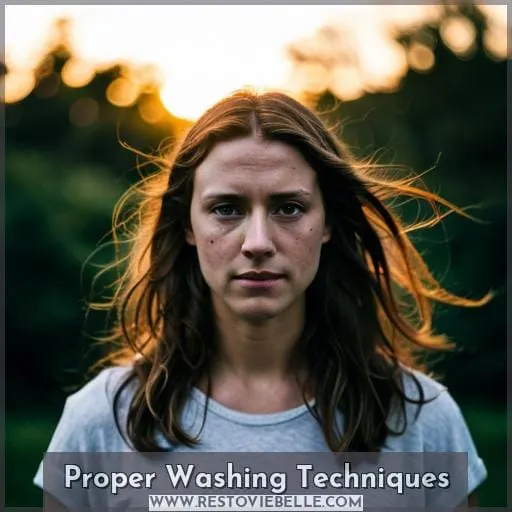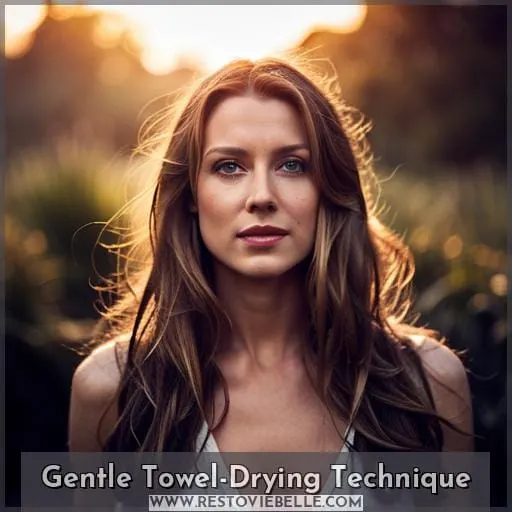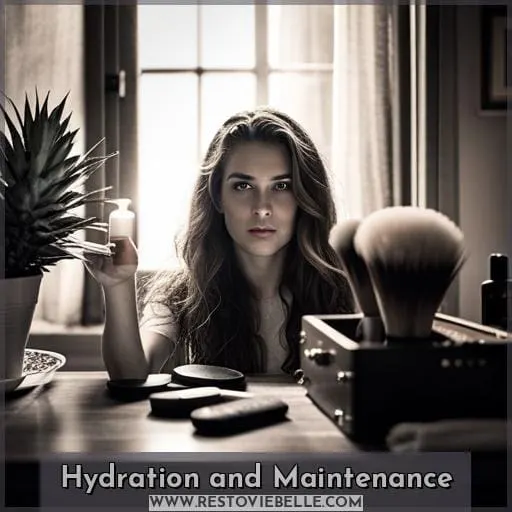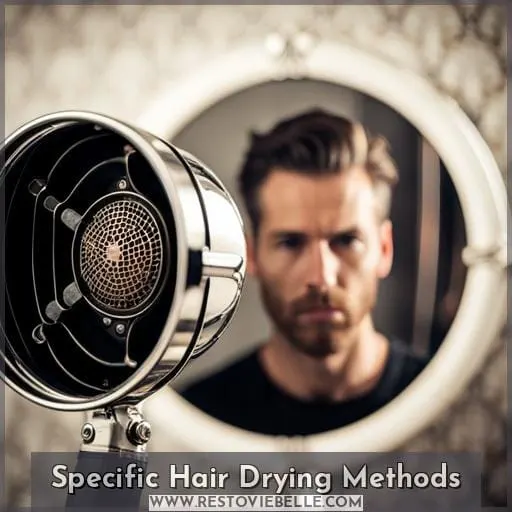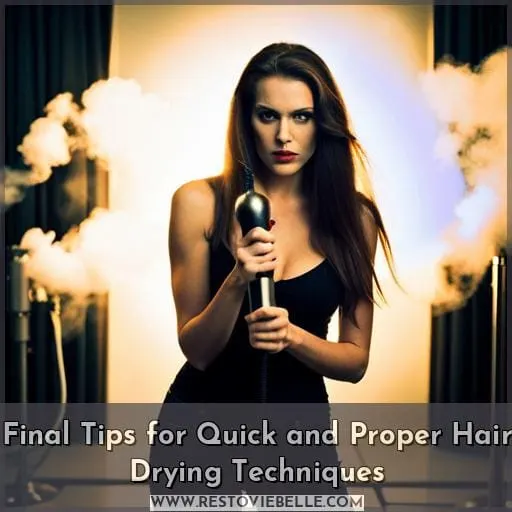This site is supported by our readers. We may earn a commission, at no cost to you, if you purchase through links.
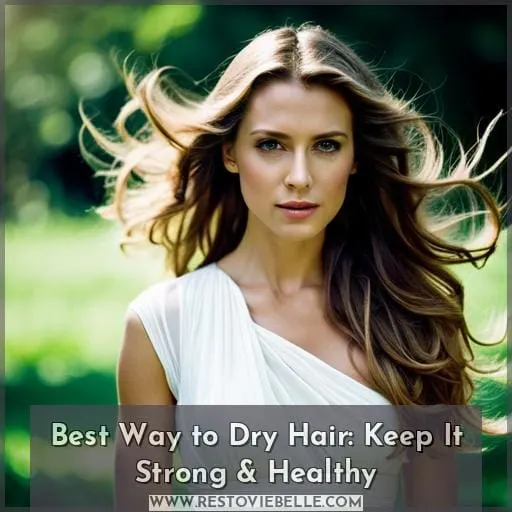 Are you ready to get your hair game on point? We all know that a bad hair day can put a damper on even the best of days, so let’s make sure you avoid it!
Are you ready to get your hair game on point? We all know that a bad hair day can put a damper on even the best of days, so let’s make sure you avoid it!
The best way to dry your hair is with air-drying and we’ve got all the tips for how to do this. From consideration of different types of locks, protective products for various styles, proper washing techniques and more – our guide will have you looking fabulous in no time.
So if healthy and strong tresses are what dreams are made of, then continue reading as we give you the rundown of everything there is to know about drying your luscious locks!
Table Of Contents
- Key Takeaways
- Importance of Air-Drying Hair
- Consideration of Hair Type for Drying Methods
- Damaging Effects of Wet Hair
- Benefits of Air-Drying
- Protective Products for Thick, Coarse, Kinky, and Relaxed Hair
- Proper Washing Techniques
- Gentle Towel-Drying Technique
- Hydration and Maintenance
- Specific Hair Drying Methods
- Final Tips for Quick and Proper Hair Drying Techniques
- Frequently Asked Questions (FAQs)
- Conclusion
Key Takeaways
- Different hair types require specific drying techniques and protective measures.
- Protective products such as oils and heat protection sprays are crucial for thick, coarse, kinky, and relaxed hair.
- Fine hair benefits from protective products like root lifters or frizz control sprays.
- Hydration and leave-in conditioners are important for protecting against heat damage and breakage.
Importance of Air-Drying Hair
You can save time and money by air-drying your hair, but it’s important to consider your hair type when choosing the right techniques for you.
Start with a moisturizing shampoo and conditioner that will help protect each strand from damage. Avoid overwashing as this could lead to cortex swelling, which leads to brittleness in the long run.
For thicker types of hair, using protective products is advised before drying naturally or towel drying is recommended. However, thin strands are less prone to damage, so they may require less product usage during air-dry sessions.
T-shirt drying works best on curly tresses as it helps preserve moisture, while plopping allows for further definition of curls without causing frizzing or breakage due to its gentle technique compared to towel wrapping/rubbing, which should be avoided at all costs!
Diffusers are also great tools if used correctly. Apply styling products onto 75% wet sections, then place them gently into the diffuser bowl without disruption before increasing heat levels gradually until reaching 90%.
Consideration of Hair Type for Drying Methods
Drying your hair correctly is essential for maintaining healthy, beautiful locks. Depending on the type of hair you have – thick or thin – different techniques may be best suited for drying and styling it.
Thick hair tends to absorb more water than thin hair; therefore, extra care should be taken when air-drying or using a hairdryer to prevent damaging the cuticles and causing breakage. On the other hand, thinner strands are less likely to absorb as much moisture, so they can tolerate additional heat from blow dryers better than thicker types of hair without incurring damage.
Thick Hair
Thick hair absorbs more water, making it prone to damage when air-dried. Protective styling is essential for thicker strands; leave-in conditioners and moisturizing products are a must. When using heat tools like the diffuser, keep the setting on low and use natural drying methods such as towel or T-shirt wraps that won’t deplete moisture levels.
Heat protection sprays will help prevent cuticle damage from excessive temperatures while still creating volume and fullness without frizziness! Regularly air dry with fans under controlled conditions to reduce stress on locks due to humidity changes in the environment, then finish off with a protective product before blow-drying for best results.
Thin Hair
Thin hair is less likely to absorb water, making it more resistant to damage when air-drying. To protect against heat damage and boost volume, products like root lifters or frizz control sprays are helpful for thin hair.
For extra hydration and nourishment, leave-in conditioners will aid in keeping the scalp healthy while helping curls retain their shape for longer periods of time. Finally, protective creams can be applied before using a hairdryer on fine strands as they provide an added layer of moisture that helps prevent hair from becoming dry and brittle over time.
- Heat Protection
- Volume Boosting
- Frizz Control
- Root Lifting
- Hair Health
Damaging Effects of Wet Hair
When wet, the cortex of your hair swells and becomes brittle, making it more prone to damage. To prevent this from happening, you must find the best way to dry your hair without causing further harm. A combination of air-drying and low-heat blow-drying is a great option for most types of hair.
Cortex Swelling
When wet, the cortex of your hair swells, making it more vulnerable to breakage. To avoid damage and minimize cortex swelling, prevention techniques are recommended. These include using low heat levels when blow-drying and avoiding moisture loss from overusing a hairdryer.
Keep an eye out for cuticle cracks, as they can occur if too much heat is used. Wavy hair tends to be more prone to frizz, while curly hair needs extra moisture retention. To prevent unwanted flyaways or frizz without disrupting the curls, a microfiber towel or T-shirt works well.
All these methods should help reduce the risk of damaging your hair while drying it quickly, resulting in optimal results depending on your individual hair type – wavy, curly, etc.
Brittle Hair
You can be left with brittle hair if you don’t air-dry properly. Damaged cuticles from scalp heat and/or root volume loss are common causes of brittle ends. To avoid this, use a cool setting on your hairdryer and keep the air velocity low when using a diffuser to prevent disturbing natural texture or straight hair patterns, which could contribute to damaged hair.
Hydration is also key – use leave-in conditioners for extra protection and lock in moisture while drying without frizz! Finally, try plopping or braiding sections before diffusion for added definition.
Benefits of Air-Drying
If you have fine, wavy, straight, or curly hair – even dyed hair – air-drying your locks can be a great way to keep your tresses healthy and looking their best. From protecting the scalp from heat damage to reducing frizz and restoring moisture lost during washing, there are several benefits of using air-drying techniques on all types of hair.
Fine Hair
For fine hair, air-drying is an easy solution that helps keep your locks looking luscious and hydrated! Protective products are essential for extra protection. Consider co-washing to reduce stress on strands, followed by gentle towel drying or Sambrani natural drying.
Diffusing techniques help enhance texture while air-drying tips can give you the perfect product recommendations.
Wavy Hair
Twist your wavy locks between a cotton t-shirt and a turban towel wrap for 10 to 15 minutes – an allusion to classic hair drying techniques. Reduce heat damage by blow-drying on low with root boost, or opt for sambrani effects if you’re pressed for time.
Plopping with the t-shirt will define waves without disrupting dyeing effects; use a diffuser or hairdryer as necessary.
Straight Hair
Straight hair tends to dry quickly, so air-drying is a great option for maintaining healthy locks. Heat styling and anti-frizz products can damage the hair, but air-drying with the dabbing technique preserves natural texture while providing root boost for fine hair.
Curly Hair
When it comes to curly hair, air-drying can help define and enhance natural curls while protecting them from heat damage. Use protective products when needed, or opt for sambrani drying for a texture boost.
Towel drying reduces frizz and defines curl formation; use a hairdryer on low settings with a diffuser attachment if necessary.
Dyed Hair
Dyeing your hair can be tricky, but air-drying is a great way to keep it looking vibrant and healthy. Use dyeing techniques that minimize heat exposure, protect with styling products, cut regularly for stronger strands, and hydrate with nourishing products – all key steps of a successful hair care routine! Utilize frizz reduction methods like T-shirt drying or diffuser usage.
Protective Products for Thick, Coarse, Kinky, and Relaxed Hair
Transitioning from air-drying to protective products for thick, coarse, kinky, and relaxed hair is important as the latter needs more attention. To protect these types of hair from damage caused by heat styling tools or harsh chemicals due to overstyling, nourishing oil treatments are essential.
Hair oils can help with moisture retention, which keeps the scalp hydrated and helps prevent breakage. Heat protection sprays also play an important role in preventing damage due to high temperatures when using a blow dryer or curling iron on your tresses.
| Products | Benefits |
|---|---|
| Oil Treatments | Moisture Retention & Repair Damage |
| Heat Protection Sprays | Heat Protection & Prevention of Hair Damage |
When choosing products based on your specific hair type, it’s best to consult a professional hairstylist who will be able to provide you with tried-and-trusted advice tailored specifically towards protecting against potential damage caused by styling tools or harsh chemical use while still giving you amazing results that last all day long!
Additionally, for those looking for natural alternatives such as sambrani (a traditional Indian incense used during religious ceremonies), this is another great way to add extra shine without any added toxins that could potentially cause further harm down the line.
Using quality haircare products combined with consistent maintenance routines can make all the difference when it comes to preserving vital moisture levels necessary for keeping healthy locks throughout life’s journey!
Proper Washing Techniques
To ensure healthy and hydrated hair, it is important to wash your hair with the right products for your type of locks. Choose a moisturizing shampoo and conditioner that will nourish the scalp without stripping away natural oils.
For wavy, fine, thick, or straight hair types, opt for a regular shampoo, while co-washing is recommended for curly or coily types as it gently cleanses while introducing moisture into each strand.
Moisturizing Shampoo and Conditioner
For healthy hair, it is important to use a moisturizing shampoo and conditioner. Avoid common mistakes like too-frequent washes or using the wrong type of product for your hair type. For extra protection, incorporate mask treatments and heat protectants into your routine, along with leave-in treatments for deep conditioning.
Shampoo for Different Hair Types
Depending on your hair type, you may want to choose a shampoo that helps keep it healthy and hydrated. For fine or wavy hair, look for something gentle with heat protection; thick locks might need a root booster.
A natural thickener is helpful for curly or coily types, while frizz-control products are best suited to relaxed styles.
Co-washing for Curly or Coily Hair
Try co-washing for curly or coily hair to give your locks the nourishment and hydration they need without compromising on style.
Benefits of this method include:
- Scalp health as it doesn’t strip away natural oils needed for curl definition.
- Heat protection from blow dryers, tongs, and other hot styling tools.
- Curl definition due to its moisturizing properties that help prevent frizz.
- Hydration needs met with a sulfate-free conditioning cleanser. Plus, it’s easy to use with no harsh chemicals – perfect for busy lifestyles!
Co-washing is an effective way to keep curls looking healthy while enjoying great style results every time!
Gentle Towel-Drying Technique
Gently drying your hair is an important step in preventing frizz and maintaining healthy locks. There are various towel-drying techniques that can be adapted for different hair types, allowing you to achieve optimal styling results without damaging your tresses.
Preventing Frizz
To prevent frizz, gently towel-dry your hair and use a combination of air-drying and low-heat blow-drying. For maximum protection against hair damage, opt for natural ingredients like olive oil or aloe vera gel to help seal in moisture.
To maximize root volume and protect from heat styling tools, try using a volumizing mousse followed by the diffuser technique. This will enhance your natural texture without causing disruption to curls or waves.
Choose products that are free of sulfates, such as Carol’s Daughter Hair Milk Cleansing Conditioner, which helps detangle kinks while deeply moisturizing the scalp.
Lastly, don’t forget to apply leave-in conditioners with anti-frizz properties for long-lasting hydration that prevents breakage due to dryness!
Techniques for Different Hair Types
No matter your hair type, you can use a variety of drying techniques to avoid frizz and keep your locks looking luscious.
For air-drying, try protective oils or pre-styling products for thicker textures.
Easy combing with a Tangle Teezer brush is great for all types, while natural solutions like aloe vera gel are ideal for sensitive scalps.
When blow-drying, consider air quality. Set low heat levels and maintain distance from the scalp to reduce cuticle cracks.
Sambrani lighting also provides fast, natural drying without damaging wetness effects on the cortex – plus, it’s beneficial for health!
Finally, diffusers enhance texture by reducing velocity. Apply styling product, then place in a bowl before defining curls and finishing off roots with volume fluffing.
Hydration and Maintenance
Maintaining hydrated hair is essential for healthy, manageable locks. To achieve this, using leave-in conditioner and detangler will provide a break from heat styling that can damage your hair over time.
Taking these few simple steps each day can help ensure your hair looks its best while avoiding unnecessary stress on strands.
Importance of Hydration
It’s vital to keep your hair hydrated, especially after drying it out with heat-styling or air-drying techniques. Heat damage can be avoided by using a leave-in conditioner and detangler for all types of hair.
This will ensure scalp health and natural drying while protecting against frizziness and breakage.
For those who prefer blow-drying, opt for low heat settings combined with protective products specific to their hair type.
Leave-in Conditioner and Detangler
For maximum hydration, try using a leave-in conditioner or detangler on your hair. Carol’s Daughter Hair Milk Cleansing Conditioner is ideal for extra nourishment and definition if you have curly strands that tend to get frizzy.
It offers anti-frizz protection, heat protection, natural drying benefits, and improved hair health. Products like Keranique Volumizing Hair Mousse provide volume, while organic aloe vera gel can soothe sunburns or cuts without residue or crunch.
Break From Heat-Styling
Take a break from heat-styling to give your hair the hydration it needs. Leave-in conditioner and detangler are great for frizz control, boosting volume, and restoring natural texture. Low heat settings on hairdryers can help reduce damage caused by high temperatures while still giving you the desired look.
Specific Hair Drying Methods
When it comes to drying hair, there are several specific techniques that can be used to achieve the best results. Towel drying is effective at absorbing excess water but should be done gently. The hairdryer technique involves applying styling product and drying in sections with low heat settings.
Using a t-shirt is great for preventing frizz, while plopping helps define curls or waves. Sambrani natural drying draws out moisture quickly and efficiently, whereas diffuser usage adds volume without disturbing your curls.
For newbies just starting out with using a diffuser, apply styling products on 75% wet hair before placing sections into the bowl of the device.
Towel Drying
Gently dab and squeeze excess water from your hair for 10-15 minutes with a high-quality towel to prevent frizz. Use heat settings, product choice, and texture type tailored to you; maintain control over unruly locks! Towel drying allows natural curls to be defined without disruption while also keeping the scalp hydrated.
Hairdryer Technique
Try using a hairdryer to style your hair, setting the heat and speed low. Gradually increase it as it nears 90% dry for optimal control, volume, and frizz reduction. Divide it into sections when blow-drying for the best results! Properly applied heat can help you achieve the desired look without damage.
T-shirt Drying
Using a T-shirt to dry your hair can help prevent frizz and retain moisture. Dab and squeeze excess water with a towel, wrap it in a turban for 10-15 minutes, plop curls or waves, light sambrani for quick drying.
Apply styling product and dry sections on low heat; finish with cool air. Fluff roots for volume; braid straight hair before diffusing at 75% wetness on a medium setting.
Sambrani Natural Drying
Sambrani natural drying is a great way to protect hair from heat while achieving curl definition, enhancing volume, and promoting overall healthy hair.
Diffuser Usage
Diffusing is a great way to give hair oomph without heat. Use the wrap technique, root lift products, diffuser tips, and hydration maintenance for best results.
Diffusing for Newbies
Give your hair a boost of volume and texture with the diffuser technique! Apply styling product to 75% wet hair, use the cool setting on the hairdryer. Place sections in the bowl; avoid disrupting curls/waves. Define, dry 80-90%, fluff roots for root volume–straight? Braid sections, then diffuse to prevent heat damage.
Final Tips for Quick and Proper Hair Drying Techniques
To ensure your hair looks its best, try employing a combination of quick and proper drying techniques. Natural drying can be fast and provides health benefits to the hair. For blow-drying, use a cool setting on the hairdryer for curly or wavy styles when plopping methods are employed.
To keep your locks hydrated while air-drying, use leave-in conditioner and detangler products, as well as gentle towel-wrapping techniques, to reduce frizziness.
Frequently Asked Questions (FAQs)
What products should I use for air-drying?
For air-drying, try using a nourishing shampoo and conditioner like Garnier Whole Blends Olive Shampoo. For detangling and frizz prevention, use Carol’s Daughter Hair Milk or a Tangle Teezer Detangling Brush.
To maximize volume, apply Keranique Volumizing Hair Mousse before drying for curls that shine with freedom! End your routine with Organic Aloe Vera Gel to soothe skin while protecting against breakage.
How often should I air-dry my hair?
Air-drying your hair regularly can be beneficial as it helps preserve its natural texture and reduces damage from heat styling. However, how often you should air-dry depends on your individual needs. If you have fine or thin hair, avoid overdoing it – a few times per week is plenty to keep the locks soft and healthy-looking! For thick or curly hair types, though, more frequent drying may be necessary for optimal results.
Is air-drying better than blow-drying?
Air-drying is often better than blow-drying, as it preserves more of your hair’s natural moisture and can reduce damage by up to 40%. Avoid heat styling tools when possible; air-dry with a few simple techniques like towel drying and using a diffuser for extra volume.
How can I protect my hair while air-drying?
Protect your hair while air-drying by using a gentle towel-drying technique, applying moisturizing shampoo and conditioner before washing, utilizing protective products for thick or coarse hair types, adding leave-in conditioners to retain hydration levels and reduce frizz.
How do I know when my hair is completely dry?
You can tell when your hair is completely dry by feeling the texture; it should be soft and smooth, not stiff or brittle. As an allegory, think of a freshly baked cake: you want to ensure every inch is cooked through before taking it out of the oven! Similarly, with drying hair – check for softness and ensure all moisture has evaporated.
Conclusion
Drying your hair properly is essential for keeping it healthy and strong. Take the case of Kavya, who has fine and wavy hair. She adopted the best way to dry her hair – air-drying it with a gentle towel-drying technique and a low-heat blow-drying combination.
She also used protective products for her hair type and incorporated moisturizing shampoos and conditioners into her routine. She was able to maintain beautiful and healthy hair without compromising on style.
No matter the type of hair you have, there are techniques that will work best for you. Following a proper hair care routine with the right products and drying techniques can help keep your hair strong and healthy.
Air-drying hair is the best way to dry your hair, but you may want to incorporate some of the other methods mentioned in this article to find the one that works best for you.
